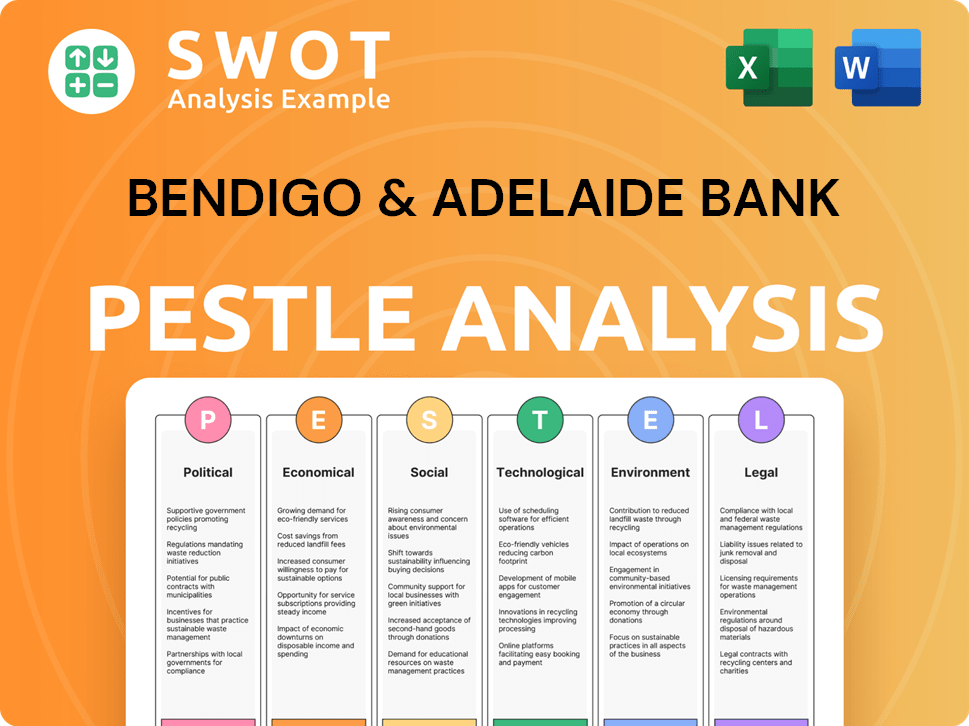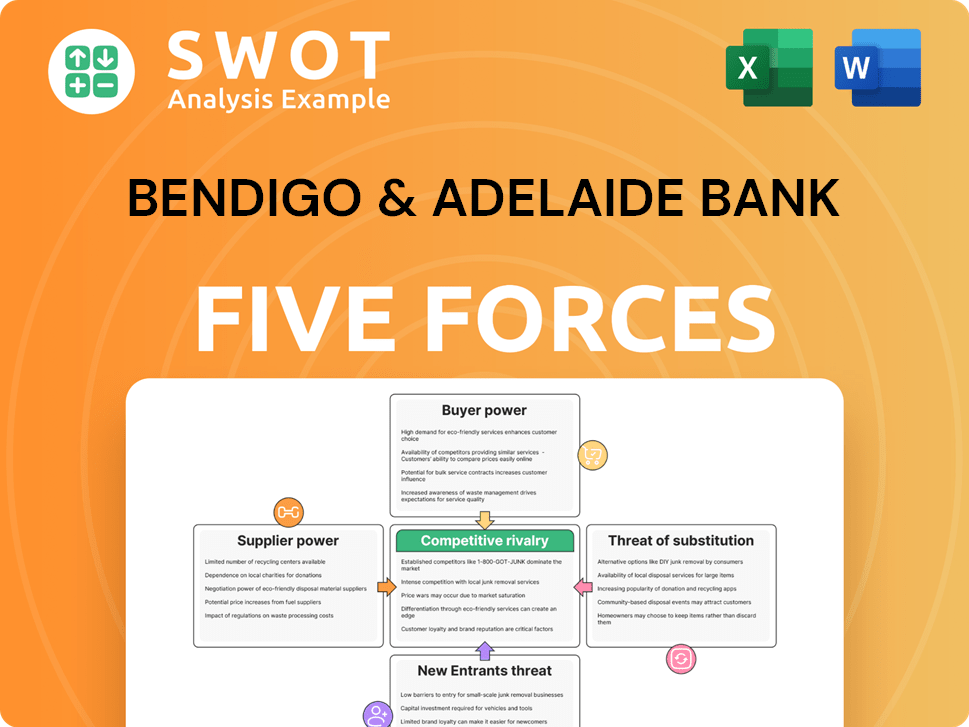Bendigo & Adelaide Bank Bundle
Can Bendigo and Adelaide Bank Thrive in Australia's Cutthroat Banking Arena?
The Australian banking industry is a battlefield, and Bendigo and Adelaide Bank is a key player, constantly vying for market share. Facing off against giants and nimble fintechs, how does Bendigo and Adelaide Bank differentiate itself? This analysis dives deep into the Bendigo & Adelaide Bank SWOT Analysis, exploring its strengths, weaknesses, opportunities, and threats within the competitive landscape.

Understanding the competitive landscape is crucial for investors and strategists alike. This piece provides a comprehensive banking industry analysis, examining Bendigo and Adelaide Bank's market position and its key rivals. We'll dissect its financial services offerings, evaluate its market share, and assess the challenges and opportunities shaping its future outlook, including its recent performance review. This study offers actionable insights for anyone interested in the financial performance of Adelaide Bank or the competitive advantage of Bendigo Bank.
Where Does Bendigo & Adelaide Bank’ Stand in the Current Market?
Bendigo and Adelaide Bank holds a notable position in the Australian banking sector, often considered the fifth-largest retail bank. The bank's core operations encompass a wide array of financial services, catering to both retail and business clients. This includes home loans, personal loans, credit cards, everyday accounts, business banking solutions, wealth management, and insurance products, positioning it as a comprehensive financial services provider.
The bank differentiates itself through its community bank model and a focus on personalized customer service. This approach has cultivated strong customer loyalty, particularly in regional and rural areas where its branch network remains a vital community asset. This strategy allows it to compete effectively against larger, more transactional banks, emphasizing relationships and local engagement.
As of its half-year results for FY24 (ending December 31, 2023), the bank reported a statutory net profit after tax of $277.2 million, a decrease of 7.2% compared to the prior corresponding period, primarily due to increased competition and a normalization of interest rates. However, its common equity tier 1 (CET1) capital ratio remained strong at 10.3%, indicating solid financial health. The bank's market share in key segments like residential mortgages and household deposits hovers around 2% to 3%, which is substantial enough to be a meaningful competitor within the Australian banking industry.
Bendigo and Adelaide Bank's market share in residential mortgages and household deposits is approximately 2% to 3%. This positions the bank as a significant player, though smaller than the "Big Four" banks. The bank's focus on community banking and personalized service helps maintain its market position.
The bank has a broad geographic presence across Australia, with branches, agencies, and expanding online platforms. It maintains a particularly strong presence in regional and rural communities. This extensive network supports its community banking model and customer service focus.
For the half-year ending December 31, 2023, the bank reported a statutory net profit after tax of $277.2 million. The CET1 capital ratio stood at 10.3%, showing a strong financial position. The bank's financial performance is influenced by competitive pressures and interest rate changes.
The bank's competitive strategy centers on its community bank model and personalized customer service. This approach differentiates it from larger competitors. The bank leverages its strong customer relationships and local presence to maintain its market share.
Bendigo and Adelaide Bank's primary differentiator is its community banking model, which fosters strong customer loyalty, especially in regional areas. The bank faces challenges from larger competitors and changing market dynamics, including the need to adapt to digital banking trends. Understanding the Revenue Streams & Business Model of Bendigo & Adelaide Bank is crucial for a comprehensive banking industry analysis.
- Community Banking Model: Focus on local engagement and personalized service.
- Geographic Focus: Strong presence in regional and rural areas.
- Financial Health: Demonstrated by a solid CET1 capital ratio.
- Competitive Pressures: Facing challenges from larger banks and market changes.
Bendigo & Adelaide Bank SWOT Analysis
- Complete SWOT Breakdown
- Fully Customizable
- Editable in Excel & Word
- Professional Formatting
- Investor-Ready Format

Who Are the Main Competitors Challenging Bendigo & Adelaide Bank?
The Competitive landscape for Bendigo and Adelaide Bank in the Australian financial services market is multifaceted, encompassing a range of players from established major banks to emerging fintech companies. A thorough banking industry analysis reveals a dynamic environment where market share battles are constant, influenced by factors such as interest rate movements, regulatory changes, and technological advancements. Understanding Bendigo and Adelaide Bank's competitors is crucial for assessing its market position and formulating effective strategies.
Bendigo and Adelaide Bank's ability to compete effectively depends on its ability to differentiate itself in a crowded market. The bank's strategy often focuses on customer service and community engagement, which can provide a competitive advantage against larger, more impersonal institutions. Assessing the financial performance and strategic moves of its key rivals is essential for Bendigo and Adelaide Bank to maintain and grow its market share. For more details about the bank's target audience, see Target Market of Bendigo & Adelaide Bank.
The competitive landscape includes significant challenges and opportunities. The rise of digital banking and fintech companies presents both a threat and an opportunity for Bendigo and Adelaide Bank. While these newer players may disrupt traditional banking models, they also drive innovation and force established institutions to adapt. The bank must continue to evolve its offerings and leverage technology to remain competitive.
The 'Big Four' banks, including Commonwealth Bank of Australia (CBA), Westpac, ANZ, and NAB, are Bendigo and Adelaide Bank's primary competitors. These banks have substantial resources and extensive branch networks.
Bendigo and Adelaide Bank also competes with smaller regional banks like Bank of Queensland (BOQ) and Suncorp Bank. These banks often focus on similar customer segments and emphasize personalized service.
Mutual banks and credit unions, such as Teachers Mutual Bank and CUA, offer competition, particularly in specific niches. They often have strong customer loyalty due to their member-owned structures.
The rise of digital banking and fintech companies, including neobanks like Judo Bank and various online lenders, presents a significant competitive challenge. They disrupt traditional models through innovative technology and lower fees.
The competitive landscape is dynamic, with ongoing battles for market share in home lending, deposits, and business banking. These battles are often influenced by interest rate movements, regulatory changes, and technological advancements.
Technological advancements play a crucial role in shaping the competitive landscape. Banks that invest heavily in technology and offer digital services are better positioned to attract and retain customers.
An in-depth competitor analysis is crucial for Bendigo and Adelaide Bank to understand its position in the market. This involves assessing the strengths and weaknesses of each competitor, their strategies, and their market share.
- Commonwealth Bank of Australia (CBA): CBA often holds a significant market share in home loans, frequently exceeding 25%. It offers a comprehensive range of products and services.
- Westpac Banking Corporation: Westpac competes across all major banking segments, including mortgages, business lending, and wealth management.
- Australia and New Zealand Banking Group (ANZ): ANZ is a major player in the Australian banking sector, with a strong presence in retail and commercial banking.
- National Australia Bank (NAB): NAB competes across various banking segments and has a significant presence in business banking and wealth management.
- Bank of Queensland (BOQ): BOQ focuses on personalized service and often targets similar customer segments as Bendigo and Adelaide Bank.
- Suncorp Bank: Suncorp Bank competes in the retail banking sector, offering a range of financial products and services.
- Mutual Banks and Credit Unions: These institutions, like Teachers Mutual Bank and CUA, often compete by offering specialized services or focusing on member-owned structures.
- Fintech Companies: Neobanks and online lenders are disrupting traditional banking models through innovative technology and streamlined processes.
Bendigo & Adelaide Bank PESTLE Analysis
- Covers All 6 PESTLE Categories
- No Research Needed – Save Hours of Work
- Built by Experts, Trusted by Consultants
- Instant Download, Ready to Use
- 100% Editable, Fully Customizable

What Gives Bendigo & Adelaide Bank a Competitive Edge Over Its Rivals?
The competitive landscape for Bendigo and Adelaide Bank is shaped by its unique community banking model and its strategic focus on customer-centricity within the Australian financial services sector. The bank differentiates itself from larger competitors through its strong brand equity, built on trust and local community engagement. This approach has allowed it to maintain a solid market position and customer loyalty, even amidst aggressive competition from major players in the banking industry analysis.
Key strategic moves involve continuous investment in digital transformation to enhance customer experience and operational efficiencies. This is balanced with preserving its community-focused service model. The bank's agility and responsiveness, compared to its larger rivals, enable quicker decision-making and adaptation to market changes. This positions it well to compete effectively and maintain its market share.
Bendigo and Adelaide Bank's competitive edge is further strengthened by its efficient operational model and prudent risk management, which support its profitability. The bank's ability to tailor services to regional needs and maintain high customer satisfaction levels are critical advantages. The bank's commitment to sustainability and community involvement also resonates with customers, enhancing its brand value and competitive standing within the financial services sector.
Bendigo and Adelaide Bank's community banking model allows local communities to share in branch profits. This model fosters strong customer loyalty and community ties. This approach translates into a more stable deposit base and higher customer retention rates, a key differentiator in the competitive landscape.
The bank's brand is built on trust and a commitment to local communities. This differentiates it from larger banks and contributes to a strong Net Promoter Score (NPS). This high NPS indicates customer satisfaction and willingness to recommend the bank, a key advantage in the banking industry analysis.
The bank invests in digital transformation to enhance customer experience and operational efficiencies. This includes initiatives to combine digital convenience with its personalized service model. This strategic move is crucial for maintaining competitiveness in a rapidly evolving financial landscape.
Bendigo and Adelaide Bank's structure allows for quicker decision-making and responsiveness to market changes. This agility enables the bank to adapt to customer feedback and market dynamics more effectively than its larger competitors. This is a significant advantage in a competitive environment.
Bendigo and Adelaide Bank's competitive advantages include its community banking model, strong brand equity, and digital transformation efforts. These advantages are crucial for its success within the Australian financial services sector. For more details on how the bank is growing, see Growth Strategy of Bendigo & Adelaide Bank.
- Community Banking: Fosters customer loyalty and strong ties.
- Brand Trust: Built on a commitment to local communities.
- Digital Innovation: Enhances customer experience and operational efficiency.
- Agility: Quicker decision-making and responsiveness to market changes.
Bendigo & Adelaide Bank Business Model Canvas
- Complete 9-Block Business Model Canvas
- Effortlessly Communicate Your Business Strategy
- Investor-Ready BMC Format
- 100% Editable and Customizable
- Clear and Structured Layout

What Industry Trends Are Reshaping Bendigo & Adelaide Bank’s Competitive Landscape?
The Australian banking industry is currently undergoing significant transformation, influencing the competitive landscape for institutions like Bendigo and Adelaide Bank. Key trends include the rapid adoption of digital technologies, evolving customer expectations, and regulatory changes. These factors create both challenges and opportunities for financial services providers, impacting their market share and strategic positioning. Understanding these dynamics is crucial for assessing Bendigo and Adelaide Bank's market position and future prospects.
Bendigo and Adelaide Bank faces a dynamic environment, with its success contingent on adapting to technological advancements, managing regulatory compliance, and navigating economic uncertainties. The bank's ability to compete effectively depends on its strategic responses to these industry-wide trends, its operational efficiency, and its capacity to innovate and meet evolving customer needs. This requires a thorough banking industry analysis to understand the underlying forces shaping the competitive landscape.
Digital transformation is a primary driver, with increasing customer demand for online and mobile banking services. Regulatory changes, particularly in consumer protection and data privacy, add complexity. Economic factors like inflation and interest rate fluctuations influence consumer behavior and lending activity. Bendigo and Adelaide Bank needs to respond to these trends to remain competitive.
Scaling digital offerings to match larger banks while maintaining a community-centric model presents a challenge. Intense mortgage market competition, including aggressive pricing, compresses net interest margins. Competition from fintechs and neobanks targeting specific services also poses a threat. Attracting and retaining skilled talent in technology and data analytics is crucial.
Leveraging strong community ties to enhance digital customer engagement offers a significant advantage. Expanding wealth management and insurance offerings can diversify revenue streams. Strategic partnerships with fintechs can provide innovative solutions. A community-focused model can resonate with environmentally and socially conscious consumers.
The bank's competitive position will likely evolve toward a hybrid model. This model combines a strong community presence with advanced digital capabilities. This approach allows it to remain resilient and capitalize on emerging growth opportunities. The bank's ability to adapt and innovate will be key to its future success.
Bendigo and Adelaide Bank must balance its community focus with the need for digital innovation. This includes investing in technology and data analytics to enhance customer experience and operational efficiency. Strategic partnerships and diversification of revenue streams are also important.
- Focus on Digital Transformation: Invest in online and mobile banking platforms.
- Enhance Customer Engagement: Leverage community ties for personalized digital services.
- Diversify Revenue Streams: Expand wealth management and insurance offerings.
- Strategic Partnerships: Collaborate with fintechs for innovative solutions.
Bendigo & Adelaide Bank Porter's Five Forces Analysis
- Covers All 5 Competitive Forces in Detail
- Structured for Consultants, Students, and Founders
- 100% Editable in Microsoft Word & Excel
- Instant Digital Download – Use Immediately
- Compatible with Mac & PC – Fully Unlocked

Related Blogs
- What are Mission Vision & Core Values of Bendigo & Adelaide Bank Company?
- What is Growth Strategy and Future Prospects of Bendigo & Adelaide Bank Company?
- How Does Bendigo & Adelaide Bank Company Work?
- What is Sales and Marketing Strategy of Bendigo & Adelaide Bank Company?
- What is Brief History of Bendigo & Adelaide Bank Company?
- Who Owns Bendigo & Adelaide Bank Company?
- What is Customer Demographics and Target Market of Bendigo & Adelaide Bank Company?
Disclaimer
All information, articles, and product details provided on this website are for general informational and educational purposes only. We do not claim any ownership over, nor do we intend to infringe upon, any trademarks, copyrights, logos, brand names, or other intellectual property mentioned or depicted on this site. Such intellectual property remains the property of its respective owners, and any references here are made solely for identification or informational purposes, without implying any affiliation, endorsement, or partnership.
We make no representations or warranties, express or implied, regarding the accuracy, completeness, or suitability of any content or products presented. Nothing on this website should be construed as legal, tax, investment, financial, medical, or other professional advice. In addition, no part of this site—including articles or product references—constitutes a solicitation, recommendation, endorsement, advertisement, or offer to buy or sell any securities, franchises, or other financial instruments, particularly in jurisdictions where such activity would be unlawful.
All content is of a general nature and may not address the specific circumstances of any individual or entity. It is not a substitute for professional advice or services. Any actions you take based on the information provided here are strictly at your own risk. You accept full responsibility for any decisions or outcomes arising from your use of this website and agree to release us from any liability in connection with your use of, or reliance upon, the content or products found herein.